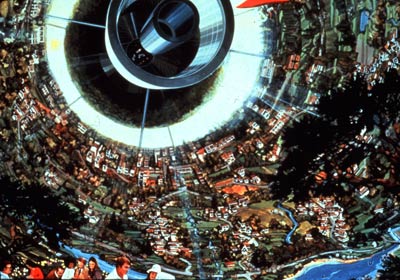The other 40th anniversaryby Bob Werb
|
| Dr. O’Neill’s human-focused view of space as a place with the resources to solve environmental, economic, and social problems is slowly supplanting the earlier view of space as a program of taxpayer-funded adventure. |
Less than three months after billions of people were transfixed by “one small step” a Princeton physics professor named Gerard K. O’Neill walked into a classroom with less than a dozen undergraduates and asked a seemingly simple question: “Is the surface of a planet really the right place for an expanding technological civilization?” This event passed with so little notice that nobody I contacted can figure out the precise day to celebrate the anniversary. The best we know for sure is that it happened before October 14th, 1969, probably during the first week of October. And yet, this unnoted moment would change the world.
Others would follow varying paths to similar conclusions as Dr. O’Neill and his class. But speaking quietly and articulately, from a position of great authority, Gerry O’Neill created a movement that would come to be called NewSpace. He wrote The High Frontier, a bestseller translated into many languages; started the Space Studies Institute and the influential Space Manufacturing conferences; appeared on television before an audience of millions; and personally recruited all three of the founders of the Space Frontier Foundation, an organization of people dedicated to using the nearly unlimited resources of our solar system to both protect Earth’s fragile biosphere and create a freer and more prosperous life for each generation.
While many technical details have changed during the last forty years, Dr. O’Neill’s human-focused view of space as a place with the resources to solve environmental, economic, and social problems is slowly supplanting the earlier view of space as a program of taxpayer-funded adventure. Even before the first energy crisis, Dr. O’Neill’s was looking to space to solve the energy problems that most people didn’t even know we had.
| In so many ways we owe it all to Gerard K. O’Neill, who had the vision to ask the right question. |
Today, NewSpace companies are springing up like weeds in the cracks ignored by big government programs. Experiences once reserved for government employees—zero-G airplane rides and visits to the International Space Station—are available to paying customers. And this is just the beginning. Within a few years NewSpace companies will be taking customers on suborbital flights, building the best spacesuits in the world, breaking lighter-than-air altitude records, landing rovers on the Moon, launching large space habitats, and, best of all, making buckets of money in the process. Even government space agencies are starting to use new approaches and reorienting toward solving problems here on Earth.
NewSpace is growing rapidly and will eventually become a multi-billion dollar industry, the core of a spacefaring civilization, capable of fulfilling our grandest dreams. In so many ways we owe it all to Gerard K. O’Neill, who had the vision to ask the right question.
